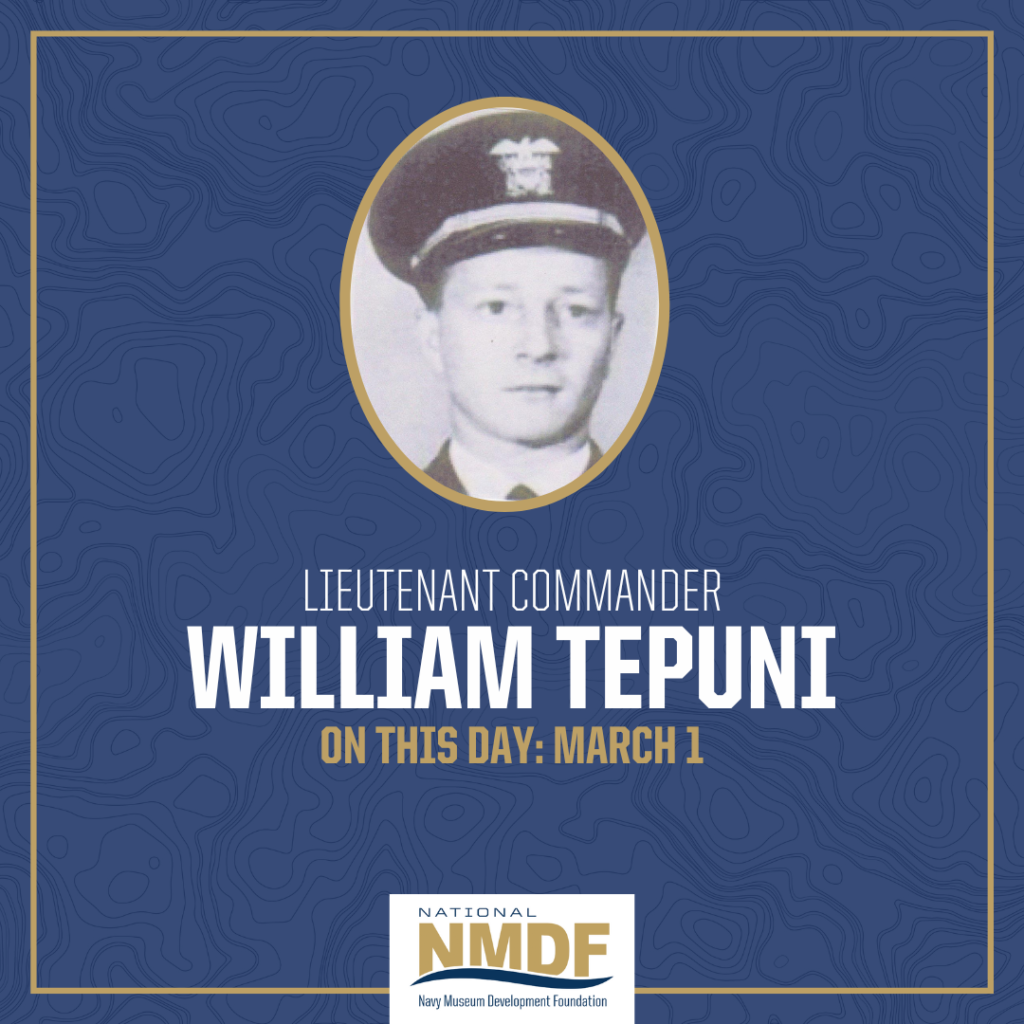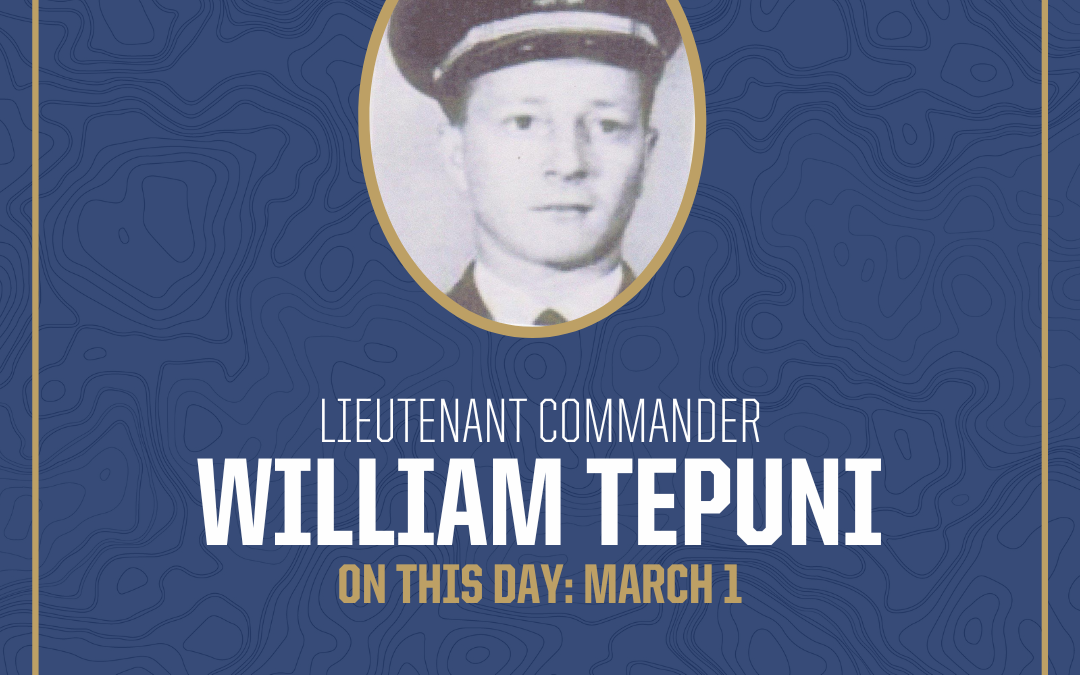MARCH 1
A Tribute to LCDR William Tepuni, USNR: A Naval Hero of World War II
When Tepuni joined VP-44 in Sand Island, Washington, flying the P2Y3 Ranger, the world was teetering on the edge of chaos. Amidst shifting tides, as the squadron sign transformed from VP-61 to VP-82 with relocations from California to Florida and training in anti-submarine warfare tactics at Floyd Bennett Field, New York, Tepuni adjusted to the many faces of the burgeoning conflict.
Born into the heart of San Francisco on October 30, 1915, William “Bill” Tepuni, the son of immigrant parents, embarked on a military career that would etch his name into the annals of American naval history. His early commission as an Ensign in June 1940 was the prologue to a series of valorous deeds as a member of the U.S. Navy Reserve.

In a historic policy change that empowered the Navy to incorporate land-based patrol squadrons for the first time, VP-82 came to possess twenty Lockheed PBO-1 Hudson aircraft repurposed from the British Lend Lease program — and Tepuni’s squadron was poised at the vanguard of American aeronautical warfare.
The gears of war turned fast, and by early 1942, Tepuni found himself in Newfoundland’s Argentia, safeguarding the crucial Atlantic convoys. It was here, aboard his trusty aircraft, that he braved cold skies to sight and subsequently send U-656, an enemy submarine, to its watery grave — marking the U.S. Navy’s inaugural U-boat kill of the Second World War.
For his courage, Tepuni received the Distinguished Flying Cross in April of that same fateful year. Promotions followed as he rose to Lieutenant and later became involved with Anti-Submarine Development on the Atlantic front, testing the Ventura aircraft and sharpening the sword of aerial warfare with emerging tactics and new rocketry.
Tepuni’s story took a turn toward the tropical as he transferred to VB-128 (which would become VP-1), situated in the strategic locale of San Juan, Puerto Rico. There, amidst the azure Caribbean, the stalwart aviator prepared for the new threat of heavily armed U-boats, equipping and training his squadron in the use of standoff rockets.
The Pacific later called to Tepuni, now a Lieutenant Commander and overseeing his team from Midway Island to Pearl Harbor, conducting patrols and reconnaissance vital to the war effort. His service trajectory culminated in the Philippines, where he was instrumental in coastal patrols around Borneo and offensive sorties against entrenched Japanese forces.
Fate took a final turn for Lt. Cmdr. Tepuni in March 1945 during a daring assault against a Japanese mini-submarine nestled in Cebu City. Though the initial strike was met with limited success, Tepuni’s unyielding spirit led him to direct a second sortie laden with 500-pound bombs. It was in this action that he fell, his aircraft brought down by enemy fire, and the nation lost a valiant warrior and his crew.
Lt. Cmdr. William Tepuni is forever marked as the commander credited with the first U-boat vanquished by the United States during the war. His command extended across multiple aircraft types, both seaborne and land-based, exhibiting skill and adaptability. Beyond his Distinguished Flying Cross adorned with two gold stars, the Air Medal with three, the Purple Heart’s posthumous award, and the Soviet Order of Glory, Tepuni’s legacy endures through Tepuni Hall at NAS Jacksonville and his hallowed rest in the Manila American Cemetery.
Revered amongst his peers and honored beyond his years, LCDR William Tepuni’s tale is one of bravery, sacrifice, and unyielding commitment to his nation and its allies. He flew as a guardian of the sea and sky, and he rests a hero of history – a testament to the American spirit and its ceaseless call to the heroic and steadfast heart.
DISTINGUISHED FLYING CROSS CITATION ONE
FOR ACTION TAKEN MARCH 1, 1942
The President of the United States of America takes pleasure in presenting the Distinguished Flying Cross to Ensign William Tepuni (NSN: 0-83095), United States Navy, for extraordinary achievement while participating in aerial flight in the line of his profession, displayed on March 1, 1942, while participating in an aerial flight as pilot of a U.S. Navy Patrol Plane. His alertness, skill and correct estimate of the situation resulted in a prompt, and well executed attack. His performance of duty on this occasion reflects great credit upon himself and the United States Naval Service.
DISTINGUISHED FLYING CROSS CITATION TWO
FOR ACTION TAKEN MARCH 21, 1945
Lt. Cmdr. William Tepuni, United States Navy, was awarded a Gold Star in lieu of a Second Award of the Distinguished Flying Cross (Posthumously) for extraordinary achievement while participating in aerial flight as pilot of a medium bomber and group leader in a patrol bombing squadron on March 21, 1945.
Historical records indicate that the submarine sunk by then Ensign Tepuni on March 1, 1942, was the German U-boat U-656 which was on its first war patrol off Cape Race, Newfoundland, when attacked. Tepuni reportedly sighted the submarine on the surface from fifteen miles away while piloting a Lockheed Hudson of VP-82 out of NAS Argentia, Newfoundland.
Apparently the submarine took no notice of the approaching aircraft which dropped two depth charges which straddled U-656 on either side. She submerged leaking oil, was unable to resurface and became the first German U-boat to be sunk by the U.S. Navy in World War II.
Records reflect that Tepuni was killed in action on March 21, 1945, while leading a VP-1 bombing raid against the Japanese at Cebu City, Philippines. After successfully bombing their target his plane was destroyed by anti-aircraft fire.
He was buried at the American Cemetery and Memorial in Manila, Philippines.

